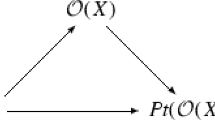Abstract
In the framework of set theory we cannot distinguish between natural and non-natural predicates. To avoid this shortcoming one can use mathematical structures as conceptual spaces such that natural predicates are characterized as structurally ‘nice’ subsets. In this paper topological and related structures are used for this purpose. We shall discuss several examples taken from conceptual spaces of quantum mechanics (‘orthoframes’), and the geometric logic of refutative and affirmable assertions. In particular we deal with the problem of structurally distinguishing between natural colour predicates and Goodmanian predicates like ‘grue’ and ‘bleen’. Moreover the problem of characterizing natural predicates is reformulated in such a way that its connection with the classical problem of geometric conventionalism becomes manifest. This can be used to shed some new light on Goodman's remarks on the relative entrenchment of predicates as a criterion of projectibility.
Similar content being viewed by others
References
Beltrametti, E. G. and G. Cassinelli: 1981,The Logic of Quantum Mechanics, Encyclopedia of Mathematics and its Applications, Vol. 15. Addison-Wesley, Reading, Massachusetts.
Dalla Chiara, M. L.: 1986, ‘Quantum Logic’, in D. Gabbay and F. Guenthner (eds.),Handbook of Philosophical Logic, Vol. III, D. Reidel, Dordrecht, pp. 427–69.
Gärdenfors, P.: 1990, ‘Induction, Conceptual Spaces, and AI’,Philosophy of Science 57, 78–95.
Goodman, N.: 1983,Fact, Fiction, and Forecast, Harvard University Press, Cambridge, Massachusetts (originally published: 1954).
Grünbaum, A.: 1973,Philosophical Problems of Space and Time, inBoston Studies in the Philosophy of Science, Vol. XII, 2nd ed., D. Reidel, Dordrecht.
Hubel, D. H.: 1988,Eye, Brain, and Vision, Scientific American Library, New York.
Lewis, D.: 1986,On the Plurality of Worlds, Basil Blackwell, Oxford.
McKie, J. R.: 1988, ‘Conventionalism, Realism, and Spacetime Structure’,Theoria LIV, 81–101.
Mulhall, S.: 1989, ‘No Smoke Without Fire: The Meaning of Grue’,The Philosophical Quarterly 39, 166–89.
Putnam, H.: 1975, ‘The Refutation of Conventionalism’, in H. Putnam (ed.),Mind, Language, and Reality, Vol. II, Cambridge University Press, Cambridge, pp. 153–91.
Quine, W. V. O.: 1969,Ontological Relativity and Other Essays, Columbia University Press, New York.
Quine, W. V. O.: 1981,Theories and Things, Belknap Press, Cambridge, Massachusetts.
Van Fraassen, B. C.: 1987, ‘The Semantic Approach to Scientific Theories’, in N. J. Nercessian (ed.),The Process of Science, Martinus Nijhoff, Den Haag, pp. 105–24.
Van Fraassen, B. C.: 1989,Laws and Symmetry, Clarendon Press, Oxford.
Vickers, S.: 1989,Topology via Logic, Cambridge University Press, Cambridge.
Author information
Authors and Affiliations
Rights and permissions
About this article
Cite this article
Mormann, T. Natural predicates and topological structures of conceptual spaces. Synthese 95, 219–240 (1993). https://doi.org/10.1007/BF01064589
Issue Date:
DOI: https://doi.org/10.1007/BF01064589



